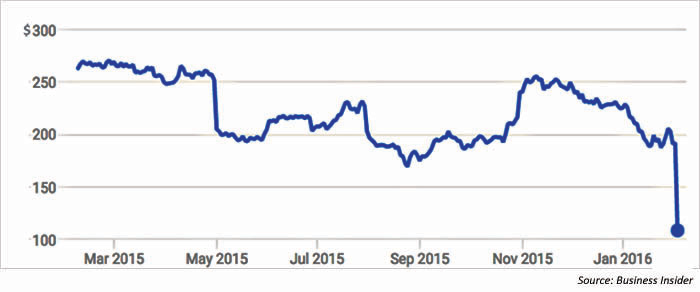
Barron’s noted this past weekend that last year’s high-flying stocks, especially “high-beta, high-multiple” names in the Internet space, are rapidly becoming this year’s worst performers.
Building on comments from Jim Paulsen, chief investment strategist at Wells Capital Management, Barron’s said: “S&P financial, health-care, consumer-discretionary, and technology groups have gone from the top of the leaderboard last year to the bottom in 2016. Meanwhile, last year’s low-beta sluggards—consumer staples, telecoms, and utilities—have come into favor in what’s shaping up to be a year of living dangerously.”
LINKEDIN CORPORATION (LNKD) SHARE PRICE

The PowerShares QQQ ETF (dominated by tech and Internet stocks) retreated last week to its lowest weekly close since October 2014 and is down close to 14% year-to-date (through 2/9/16). According to technical analysis from Kimble Charting, “The NASDAQ 100 looks to have closed last week below 5-year rising channel support … downside risks are high.”
The so-called FANG stocks (Facebook, Apple, Netflix, and Google), taken as a group, have fared just about the same as the QQQs, though Facebook has been clearly the best performer in a difficult market environment and Netflix the worst. But the one tech stock receiving an inordinate amount of attention is LinkedIn, which has seen its share price more than cut in half this year.
LinkedIn (LNKD) hit an all-time high of $276.18 in February 2015, closed out 2015 trading around $225 and last week saw its share price drop over 40% in a day on weak forward guidance (hitting an intraday low of $102.81). Business Insider called it the “worst decline ever for the stock and has erased about $10 billion of the company’s value.”
Though the company recorded year-over-year growth in revenues in its major business segments and a 22% rise in premium subscriptions, the guidance for both Q1 and full-year 2016 was well below analyst forecasts. The social network for professionals said that it expected first-quarter adjusted earnings per share (EPS) of $0.55, but analysts had estimated $0.75, according to Bloomberg. It projected full-year revenues at $3.6 billion to $3.65 billion, versus $3.9 billion expected. Additionally, said Business Insider, “LinkedIn also announced that it was killing Lead Accelerator, a business-to-business ad network it got with the 2014 acquisition of Bizo (a B-to-B marketing platform).”
The Wall Street Journal’s analysis of the situation was a little more upbeat, citing the company’s now more reasonable multiple of 33 times forward earnings, its investment in several business lines (including business intelligence data for sales professionals), and its “very real business base with a diversified revenue base.” However, they conclude, “For investors, LinkedIn [is like] a job candidate with something to prove and a greatly reduced salary demand.”
